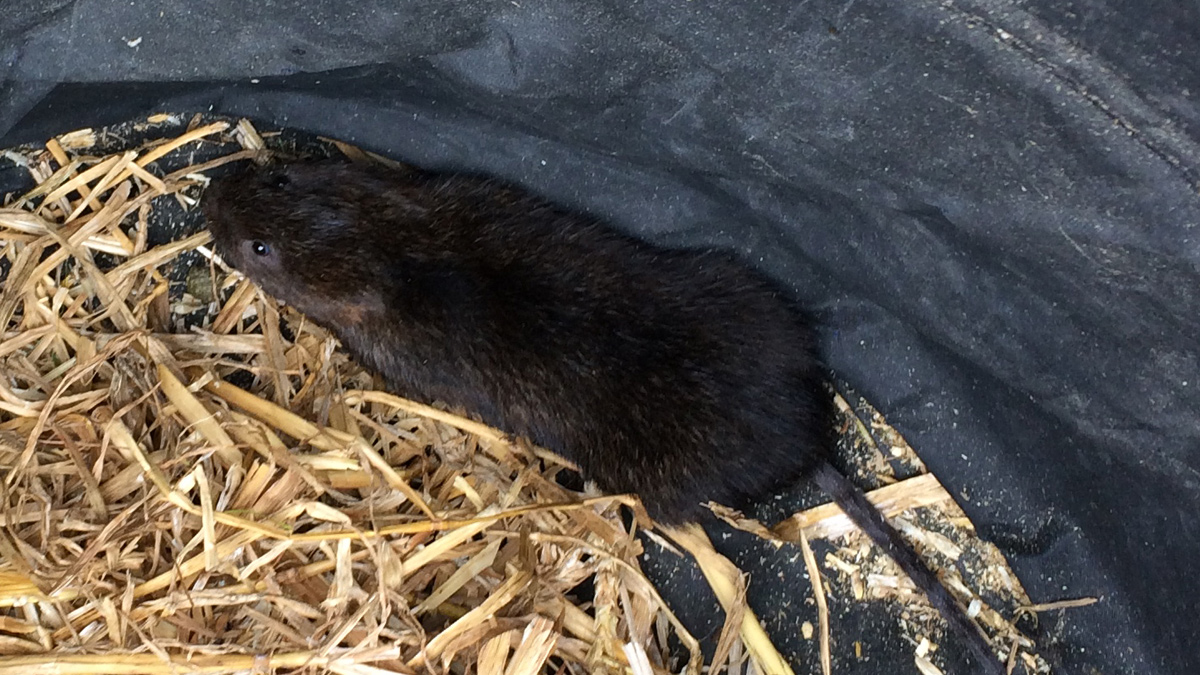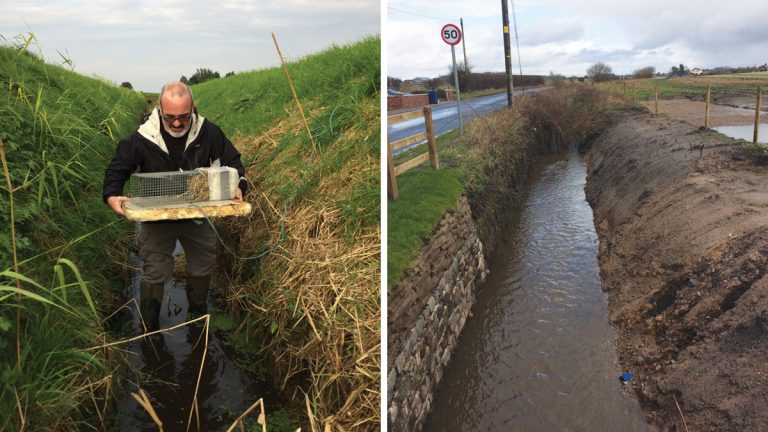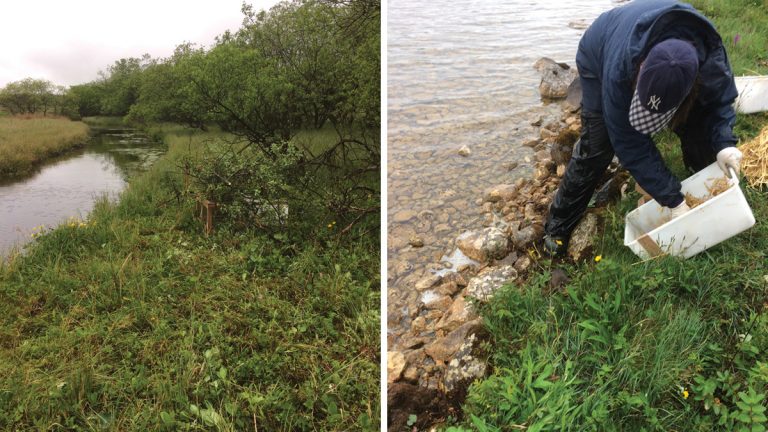Protecting Water Voles (2017)

Captured water vole - Courtesy of MWH Treatment
The advance JV Southport DMZ project for United Utilities required the installation of 30km of new clean water main across the West Lancashire area. This installation required the crossing of no fewer than 15 watercourses, each of which had the potential for water voles (a species protected under the Wildlife and Countryside Act) meaning further survey and mitigation was required. Water voles are the largest species of vole in Britain. They make their habitats in grassy banks along slow moving rivers, ditches, streams, lakes and ponds. They dig burrows in steep grassy banks, which often include underwater entrances. Water voles have undergone one of the most serious declines of any wild mammal in Britain during the 20th century due to urbanisation of floodplains and a general increase in development.
Changes to guidelines
An initial Extended Phase 1 Habitat was undertaken in 2014 which identified the potential for water voles at a number of the watercourse crossings. However, the guidance from the Mammal Society on how to effectively comply with the legislative requirements for protection, changed in early 2016, meaning that the previous approach of disturbance which could not reasonably have been avoided being classed as an “incidental result” of a lawful operation no longer stood. In the past this constituted a defence against prosecution. The changes also required that the presence or absence of water voles be confirmed through multiple surveys to allow a more robust assessment of the impacts of the project given the mobile nature of the mammal.
Although this wasn’t a change to the legislative requirements, it was a change to how these requirements were interpreted and implemented – if project team had not followed the new guidelines they would have been at risk of causing an offence.
This change was implemented after the project was tendered for but before construction commenced which presented considerable issues to the project team from a programme and cost point of view.

(left) Trapping the water voles and (right) cleared ditches after water vole trapping – Courtesy of MWH Treatment
![]() Project implications
Project implications
As a result of the above changes to legislation, advance JV were required to undertake a further two water vole surveys between mid-April to mid-June and July and September (unless evidence of water vole was conclusive).
Conclusive evidence of water vole was only found in one location – in this location the project team were able to undertake works under a Class Licence by a registered person with displacement only for a length of bank less than 50m during the period of 15th February to 16th April. This would also require a full report submitted to Natural England upon completion. These displacement activities consisted of strimming back the bankside vegetation under ecologist supervision and then returning a few days later to dig out any water vole burrows identified. Following this a layer of Visqueen is placed over the cleared area to prevent re-population, and the necessary works undertaken. The team were only able to work under this method due to the timing of the works and the conclusive evidence of water voles being present.
For all other watercourse crossings, two additional surveys were required to confirm the presence or absence of water voles, and to identify suitable mitigation. The results of the two surveys provided conclusive evidence in some circumstances but not in others. Due to the scope of works and the requirement to work in the watercourse and banks over an extended period of time, a decision was made for a European Protected Species Licence to be applied. This was to allow for the capture and relocation of any Water Voles within the working area (rather than attempting to undertake all the crossings during the window for working under a Class Licence). Where there had been mixed results from the two surveys (i.e. present during first survey but not the second and vice versa) the locations were included in the licence application to allow for final checking before undertaking the clearance works.
Capture and the ‘Vole Hotel’
Working with Ecology Services Ltd and Water Vole specialists Derek Gow Consultancy Ltd, a Science, Education and Conservation Licence was successfully applied for from Natural England. The license was needed for the disturbing, taking and possessing of water voles and allowed the ecologists to trap water voles in the necessary areas. They would be held in captivity over the winter in a purpose built facility, and then released in to Water Vole reintroduction projects at Kielder Reservoir in Northumberland, or at Malham Tarn. The aim of which was to provide a working area clear of Water Voles and to ensure no net species loss.
Upon receipt of the licence, trapping was undertaken in all relevant areas, following which a period of 5 days of no captures was allowed for. After the 5 non-capture days, the ditch systems were scraped clear of vegetation under ecologist supervision with the necessary capture equipment should water voles be encountered. Following vegetation clearance, the ditch banks were dug out and made unsuitable for water vole re-entry in to the area. The Water Voles were transported to Derek Gow Consultancy’s purpose built facility at Broadwoodwidger in Devon, which became known as ‘the vole hotel’.
A total of six water voles were captured and relocated which was significantly lower than what was expected to be encountered from the survey findings. This indicated that there is a population of mink in the area which was having a detrimental effect on the Water Vole population. Had the capture and relocation process not been undertaken, it is likely that the entire Water Vole population would have been lost. Since the capture and relocation, the pipeline installation works have commenced without issue in line with a revised programme.

(left) New habitat at Malham Tarn and (right) water voles being released – Courtesy of MWH Treatment
Relocation
Following on from last year and continuous mink monitoring of the ditches at Royal Oak and Springfield, in May 2017 Natural England have agreed that the captured water voles would be re-released to Malham Tarn early summer. Under normal circumstances any captured Water Vole would ideally be re-released into their original area. However from the mink monitoring undertook through spring it was evident that mink were in the catchment area and re-release would be detrimental to the animals’ welfare.
Prior to any reinstatement of Water Vole within the Southport DMZ catchment area a thorough mink monitoring and trapping exercise would need to be carried out which, given the size of catchment and numerous land access issues would be costly process and take numerous years to fully resolve.
The water voles were released into the Malham Tarn on Monday May 29th just under a year after being discovered by the project team. Although the mink problem meant their original habitat was no longer viable, they were successfully relocated thanks to great collaboration between the advance and the numerous environmental agencies.
Summary
The relocation of the water voles was indicative of the current environmental climate in the construction industry. Protecting potential wildlife habitats is an important part of any project and the care taken by the team demonstrated a great understanding of the environment and the new guidelines implemented.
Had there been any carelessness when dealing with the water voles there could have been serious repercussions and fines, which would have been a major setback for the project. The relocation is a great example of how important it is make the environment a priority and to make sure all guidelines, licenses and surveys are followed and completed appropriately.



